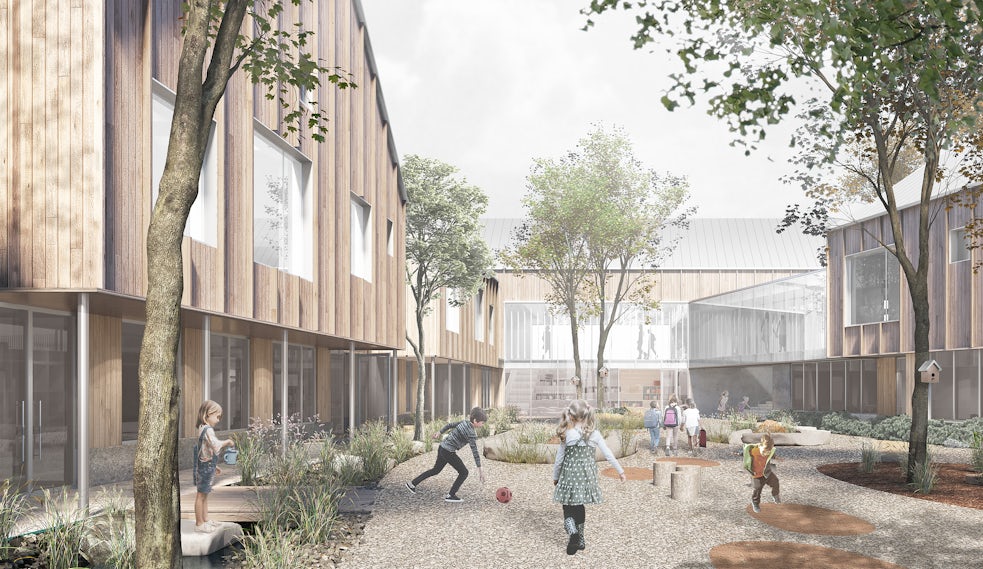New Shoots Children’s Centre, Kerikeri – Given the hospitable climate of Kerikeri, we wanted the centre to be a reflection of the environment and for children to interact with this in a more natural way. The building is split into four pavilions, each housing varying age groups of children, sheltered by a large soaring roof form tying the pavilions together, allowing for movement between spaces under cover. The roof shelters the pavilions and much of the space around them from sun and rain, providing all-weather spaces such as outdoor dining and external circulation, interspersed with pocket gardens throughout the design. Pavilions are designed so that they face the striking Pohutukawa tree located in the heart of the centre, to encourage children’s connection with the natural environment.
Architizer chatted with Phil Smith, Founder and Director at Smith Architects to learn more about this project.
Architizer: What inspired the initial concept for your design?
Phil Smith: The initial concept behind the New Shoots Children’s Centre to be a reflection of its immediate location and surroundings in Kerikeri, New Zealand. The design was to enable connection between the children and the land and natural environment which they are situated.
New Shoots Children’s Centre’s core values is “a place that feels right’. This concept is an intertwined emotional and physical response to each site that draws upon the community and typography to create a culturally relevant environment with a connection to place and a distinct human identity.
The centre was designed to be a multipurpose “Community Space” which was to be seamlessly included but not compromise the programme.

© Smith Architects

© Smith Architects
This project won in the 10th Annual A+Awards! What do you believe are the standout components that made your project win?
Typical early childhood centres resemble a simple box shape with deep plan classrooms (requiring mechanical ventilation and lighting) and a corridor joining the rooms and admin spaces. This design takes a different approach by taking a 6m deep room space, optimising natural ventilation and daylighting, and stretching that around the cross shaped plan maximising interaction with the natural environment. This design therefore maximises health outcomes whilst facilitating connection both within the centre and within the community.
The arrangement of internal spaces around a central outdoor courtyard and across outdoor play areas allows the spaces to be an extension of its outdoor environment. This is enhanced further by the large canopy allowing external spaces to be used for what are typically indoor activities – dining, art, singing, dance.

© Smith Architects

© Smith Architects
What was the greatest design challenge you faced during the project, and how did you navigate it?
One of the biggest challenges was age group segregation. The building needed to divide up age groups, particularly in the playground so that the older children did not disturb the younger children.
Another challenge we faced was the sloped site. We needed to ensure wheel chair compliant access throughout centre. There was a reasonable slope from east to west of around 4m which had to be incorporated into the design, which also had to allow accessible compliant access from the pathway outside the site all the way through the site itself.

© Smith Architects

© Smith Architects
How did the context of your project — environmental, social or cultural — influence your design?
Kerikeri being situated so far north, the climate was a large driver behind the design. The Northland climate is incredibly hospitable with winter temperatures often around 14 degrees and summer around 25 degrees. To combat this, all glazing has a low-e coating to manage heat lose in winter and heat gain in summer, ensuring a healthy indoor environment is maintained. The outdoor timber canopy connecting the four pods of the building implements polycarbonate roofing to minimise heat and glare. The canopies create all-weather play space, and access to other rooms, meaning the building can be open to outdoors and naturally ventilated most of the year.

© Smith Architects

© Smith Architects
What drove the selection of materials used in the project?
The products have been purposely selected for their low maintenance and easily repairable qualities – they are very standard NZ products arranged in a striking architectural form.

© Smith Architects
How important was sustainability as a design criteria as you worked on this project?
Construction is primarily timber and features a unique glulam diagrid roof structure. Minimal use of steel minimises the buildings overall carbon footprint. Implementation of FSC Certified sustainable timber offers a renewable solution for current global environmental issues and ecosystem destruction.

© Smith Architects
Team Members
Phil Smith and Graham Collingridge
Consultants
D Lenssen Builders Ltd, Markplan Consulting, Interiors by Chloe Forsman, Guyco Joinery, Techlam NZ, Photography by Amanda Aitken
Products and Materials
Structural Glulaminated Timber
For more on New Shoots Children’s Center, Kerikeri please visit the in-depth project page on Architizer.













 New Shoots Children's Centre, Kerikeri
New Shoots Children's Centre, Kerikeri 


